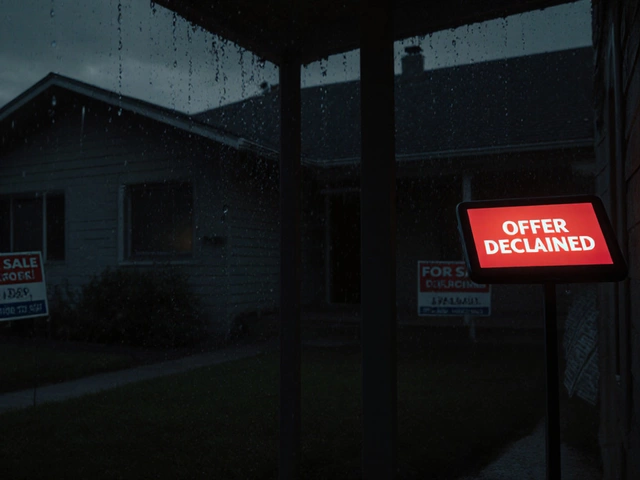Commercial real estate isn’t the stable fortress it used to be. If you’ve ever wondered why old downtown buildings seem emptier, or why huge warehouses are popping up near highways, you already see the future unfolding. Remote work, e-commerce, and a new wave of flexible businesses have flipped the classic rules on their heads.
Selling—or buying—a commercial property right now isn’t just about location, price per square foot, or finding a tenant. It’s about understanding what businesses actually want today. Offices used to be safe bets. Now? Not so much, unless the space comes with a twist, like built-in coworking or cool amenities. Meanwhile, warehouses and distribution centers have become goldmines thanks to skyrocketing online shopping.
Everyone has to think differently. If you’re thinking about making a move in commercial property, watching these changes isn’t enough. You’ve got to ask what will matter to tenants two or five years from now—and spot the trends people haven’t picked up on yet.
- What’s Shaking Up Commercial Real Estate?
- The Rise (and Fall) of Office Space
- Retail, Warehouses, and New Money Makers
- Tips for Navigating Tomorrow’s Market
What’s Shaking Up Commercial Real Estate?
If you’ve been tracking commercial real estate, you probably already know it’s getting hit by some wild changes—way faster than before. The biggest mover? The shift to remote and hybrid work. Before 2020, just 4% of Americans worked mostly from home. Now, almost 28% do. Companies are ditching long office leases and hunting for smaller, flexible spaces that can adapt to whatever comes next.
Then there’s retail. The rise of online shopping isn’t slowing down. In 2024, e-commerce made up about 22% of all retail sales in the US, compared to only 11% back in 2019. This has made big box stores and strip malls less popular, while warehouses and last-mile delivery centers are in hot demand from everyone—Amazon, Walmart, you name it.
Flexibility has become king. Businesses want spaces they can change or leave without huge penalties. Traditional 10-year leases are starting to look old-fashioned.
| Trend | 2019 | 2024 |
|---|---|---|
| Remote Work Participation | 4% | 28% |
| E-commerce Retail Share | 11% | 22% |
| Average Lease Length (office) | 7-10 years | 3-5 years |
We also can’t ignore the cost and interest rate pressure. Interest rates doubled between 2022 and 2023. That means higher loan payments and lower profits for owners unless they can raise rents—but that’s tricky when demand is shaky.
- Remote work shrinks office demand
- Online retail boosts warehouse needs
- Shorter, more flexible leases are the new normal
- Rising loan costs squeeze owners and buyers
If you want to keep up, you can’t just watch the old office and mall listings. You’ve got to look where the economy and work trends are headed because that’s where the action (and money) will shift next.
The Rise (and Fall) of Office Space
A few years back, nobody really questioned the need for big office towers. Every company wanted their name on a shiny building. But since 2020, everything’s different. A lot of businesses figured out that people can work from anywhere—and, honestly, many folks like it that way. That shift took a wrecking ball to the “every business needs a big office” rule.
The numbers don’t lie. US office vacancy rates hit record highs in 2024, pushing above 19% in big cities. Places like San Francisco and New York saw even higher vacancies, with some neighborhoods topping 25%. It’s not just about remote work, either. Companies want flexible leases and smaller footprints, leaving more empty cubicles behind.
| City | Vacancy Rate (Q1 2024) |
|---|---|
| San Francisco | 27.1% |
| New York City | 25.6% |
| Dallas | 24.2% |
| Chicago | 22.3% |
Yet, it’s not all doom and gloom. There are winners. Offices with lots of natural light, outdoor spaces, or cool features like gyms and cafes still get snapped up. Companies that need in-person work—think labs, law firms, or tech start-ups—are still renting, just being pickier. And some buildings are being flipped into apartments, coworking spaces, or even high-tech data centers instead.
If you’re looking to buy or sell in commercial real estate, here’s what actually matters with office space right now:
- Location still counts, but not just “downtown”— accessibility, parking, and public transit matter more.
- Flexible layouts rule. Wide-open spaces or the option to customize are big selling points.
- Modern amenities (think strong WiFi, good ventilation, smart security) can make or break a deal.
- Landlords are offering deals like shorter leases or move-in perks—buyers should know where to push for value.
Try not to cling to what worked five years ago. Today’s best commercial office deals are the ones that can change as fast as tenants do.

Retail, Warehouses, and New Money Makers
Retail isn’t dead, but it sure isn’t what it used to be. Malls that thrived in the '90s now have more empty spaces, and big brands are shrinking their footprints fast. What’s taking their place? Think gyms, medical clinics, gaming centers, and even fulfillment hubs. It’s all about versatility now—the retail space that sits empty is the one that refuses to adapt.
Warehouses, on the other hand, are on fire. Amazon alone has more than doubled its warehouse space since the pandemic. Over 550 million square feet of new warehouse construction hit the market in the U.S. just last year. Why such growth? Online shopping isn’t slowing down, and every package needs a place to land before hitting your doorstep.
Here are the main game-changers for these types of properties:
- Urban warehouses: Instead of building far away, companies want small, local spots for faster delivery.
- Click-and-collect retail: Stores double as mini-warehouses where customers pick up online orders.
- Medical, experience-based, and fitness tenants moving into old retail spaces.
- Data centers: With everyone streaming and gaming, even empty shopping centers can become server hubs.
If you’re eyeing commercial real estate for the long haul, keep an eye on local zoning rules—they’re changing fast to allow these shifts. A dusty strip mall next to a major highway could turn into a delivery hotspot overnight if local laws open up.
Here’s a look at how things stack up right now:
| Property Type | Vacancy Rate (2024) | Average Rent Growth, YoY |
|---|---|---|
| Retail | 5.5% | +2.1% |
| Warehouses | 3.2% | +8.4% |
| Data Centers | 2.7% | +10.3% |
Adaptability is the name of the game. Spaces that work for just one business are out. Hybrid, mixed-use, or ‘last-mile’ properties? That’s where the action’s at now.
Tips for Navigating Tomorrow’s Market
Jumping into the commercial real estate game is different now. Let’s cut to the chase—if you want to win, you’ve got to think fast, act smart, and stay ahead of the trends. Here are some tips that really matter.
- Rethink Office Space: These days, hybrid work isn’t going anywhere. According to a CBRE survey in 2024, 61% of companies said they’d stick with part-time remote options even into the next few years. Investors should look for properties that have flexible features or are easy to convert—for example, open-plan floors or smaller, ready-to-rent suites.
- Check the Zoning and Local Rules: City rules can make or break a deal. Some towns are relaxing zoning to help convert empty offices into apartments or retail. Others are still strict. Always do a local check. A quick call to city hall can save you a fortune in headaches—and wasted time.
- Follow the Money—Literally: Industrial and warehouse space is still hot thanks to the e-commerce boom. Amazon, Walmart, and others have doubled their warehouse footprints since 2020. If you spot near a major highway or port, you’re likely looking at steady rent and good resale value.
- Stay Tech-Savvy: Smart buildings—think digital security, automatic lighting, and energy use tracking—get filled faster. In 2023, JLL reported that 75% of commercial tenants prefer spaces with built-in tech upgrades. Make sure your property can handle modern needs.
Here’s a table that breaks down where commercial property interest has shifted since 2020:
| Property Type | 2020 Demand | 2024 Demand |
|---|---|---|
| Office | High | Medium/Low |
| Industrial/Warehouse | Medium | Very High |
| Retail (traditional malls) | Medium | Low |
| Mixed-use/Adaptive Reuse | Low | Rising Fast |
If you’re selling, highlight flexible uses or easy upgrades. If you’re buying, target properties close to transportation hubs or in areas where city policy is changing fast. This isn’t about guessing; it’s about knowing what’s next and acting before everyone else catches up.






